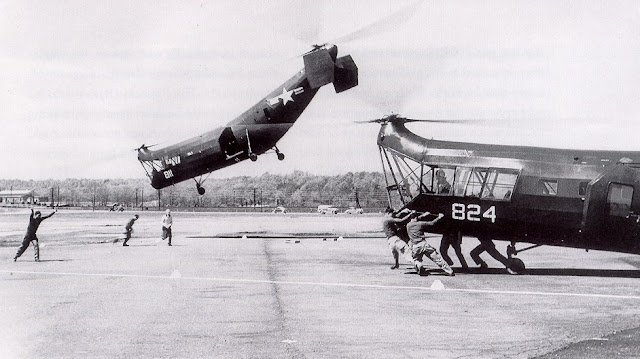At the time, based on experience with autogiros, it was believed that the empty weight of a single rotor helicopter as a percentage of gross weight would increase with rotor diameter so quickly that large single rotor helicopters would have no payload capability. Frank Piasecki, a young engineer who had just flown his first helicopter, convinced the Coast Guard and the Navy that the answer was a tandem-rotor helicopter. He got a contract for a full-scale demonstrator in January 1944.
The first flight of what was designated the XHRP-X, Bureau Number (BuNo) 37968, was made in March 1945, little more than a year after go-ahead. It was powered by a 450-hp Continental R-975 radial engine and subsequently referred to as the Dogship at Piasecki. Unique features in addition to the tandem rotors were the castering wheels intended to minimize side loads in a touchdown with sideward motion; the pilot sitting aft of the front pylon (the copilot sat directly behind him); and the bottom of the forward fuselage being "skinned" with clear plexiglass panels for downward vision. Unlike subsequent tandem-rotor helicopters, the rotors did not overlap.
The XHRP-X was featured in this late 1945 newsreel as the "World's Largest Helicopter!". Following its successful development and demonstration, Piasecki received approval to build a Static-Dynamic Test Article for qualification testing of the drive and rotor systems. It did not receive a BuNo and the fuselage was never covered with fabric. It was powered by a 600-hp engine P&W R-1340 engine.
The XHRP-1, BuNo 37969, was also authorized.
Its first flight was accomplished in March 1947. It initially had a aft fuselage without as much side area as the XHRP-X, possibly to reduce weight. Stability problems resulted in the addition of a small horizontal stabilizer and vertical fins.
Piasecki also received a production order for 10 HRP-1s in June 1946 and another 10 in April 1947.
The first production HRP-1 flew in September 1947 and was delivered later that year. The last of the total order of 20 was delivered in 1949. These were initially used by the Marine Corps to develop tactics for vertical assault and by the Coast Guard for its ongoing helicopter search and rescue development.
Five of the HRPs initially assigned to the Marines Corps were then used by the Navy for the development of dipping sonar and airborne minesweeping. The fabric was taken off to reduce weight (testing was done off Key West, Florida) and flotation bags were added so the helicopter could be recovered if its engine quit over the water.Eventually a portion of the small fleet was acquired by civil operators from military surplus.
The Dogship is currently stored at the Smithsonian's Paul E. Garber Preservation, Restoration, and Storage Facility located at Silver Hill, Maryland.
The first production HRP-1, BuNo 111809, that was at the New England Air Museum is currently being restored at Piasecki Aircraft Corporation in Essington, Pennsylvania for eventual display at the American Helicopter Museum in West Chester, Pennsylvania.
The HRP-2 utilized the same drive train and engine as the HRP-1 in an all-metal fuselage. The pilot and copilot now set side by side ahead of the front rotor mast. First flight was on 10 November 1949. Only five were produced. They were initially used by the Marines along with the HRP-1s and then all of the -2s were assigned to the Coast Guard. It was clear that they were underpowered with the same 600-hp engine installed in the HRP-1.
At least one surplus HRP-2 was procured and operated by Rick Helicopters, then the largest civil operator of rotorcraft, in the 1950s.
The Air Force and subsequently the Army recognized the value of the basic design for their emerging helicopter missions, however, and ordered modified versions of the HRP-2 as the H-21 with more powerful Wright engines with up to 1,425 horsepower.


















